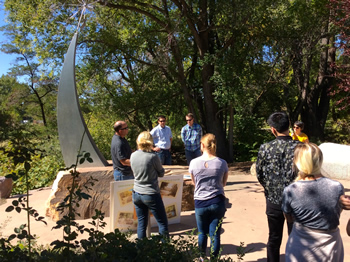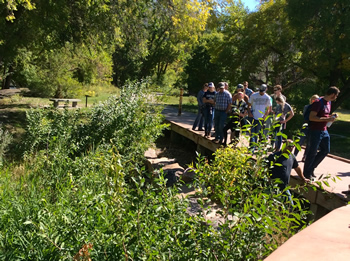News Article
January 17, 2018
Cross-Campus Collaborations Bring Classrooms Together
One of the hallmarks of the iUTAH project has been collaboration between campuses across the state. Throughout the past five years, researchers have shared ideas, equipment, and even students. This spirit of sharing has led to the development of a number of cross-institutional courses, including ones involving hydroinformatics, watershed planning and management, and green infrastructure.
The Green Infrastructure course was co-taught for the second time around this last fall at Utah State University and the University of Utah. Ryan Dupont, a professor in civil and environmental engineering at USU, had 14 students in his section of the course, while Sarah Hinners, a research assistant professor in city and metropolitan planning at UU, had 12 students, or a total of 26 students.
The class met on Friday afternoons, at their own respective campuses in technology-linked classrooms, exploring the topic of green infrastructure from planning and engineering to homelessness and social equity, and hearing from a variety of guest speakers. Field trips brought the class together to meet in-person to view and discuss local examples of Green Infrastructure planning and execution in the Ogden area. They also ran parallel field trips in Logan and Salt Lake City, and reported back to one another.
When asked about the benefits of bring the course together, Ryan Dupont said that “content and discussions we have had in the joint offering course are richer, than when I am able to offer the course myself with only engineering students making up the class roster. I find it very valuable to have students, faculty and guest lecturers with different perspectives on this subject presenting and discussion issues on GI design and implementation.”
As part of the USU section, students completed a class project to enter EPA's Campus RainWorks Challenge, for which student teams design an innovative green infrastructure project for their campus that effectively manages stormwater pollution while benefitting the campus community and the environment. At UU, four students worked with the Jordan River Commission and a state legislator to produce background research and recommendations for a proposed Jordan River State Park.
Both Dupont and Hinners said that interdisciplinary engagement has been a very positive aspect of their involvement in iUTAH, one that they hope continues into the future. “I don’t have an available co-instructor from engineering down here, and I really can’t cover that topic area well myself, but it’s critical to the topic of green infrastructure,” said Hinners. “I really love having a diversity of backgrounds, experience and expertise in the classroom.”
Other courses brought together by the iUTAH project that use this model of cross-campus collaboration include Integrated River Basin Watershed Planning and Management and Water Resources Planning taught by David Roseberg from USU and Steven Burian from UU. In 2012, a Hydroinformatics graduate course was started taught by Jeff Horsburgh and David Rosenberg from USU, along with Steve Burian from UU, and Dan Ames from BYU. The course was offered simultaneously at the three locations via interactive video conferencing and covered information on how to use computer software and hardware to collect, manage, and analyze large amounts of water-related data. The course has been offered annually since 2012, with a one-time expansion in 2014 to include faculty and students from University of Wyoming, and University of Virginia.
Syllabi for the Fall 2017 Green Infrastructure course:


« Back to list of all news articles


